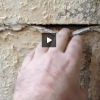The following article is a brief overview of both interior and exterior waterproofing.
Exterior waterproofing is done in one of 3 ways:
1. Exterior Coatings
The earth around the exterior of the foundation wall is removed ideally down to the footer (this is the continuous concrete block that the wall sits on). The wall is then coated with either tar, vinyl or coated with more concrete (I will not cover coating the wall with concrete as it is a total fail in every way. Concrete does not adhere to older concrete and in the presence of any moisture the different layers of concrete will separate and crumble).
Tar
Covering the wall with tar is the most common approach. This is what the builder does. The wall is cleaned and then tar is sprayed onto the wall and footer. Tar is basically waterproof and the aim is to cover the entire surface and thereby prevent the passing of water thru to the lower layer. But the problem with tart is that it will very quickly get brittle and crack at the seam where the wall meets the footer (this is a natural point of movement as a house settles or the earth around it moves slightly -as in a heavy rain or a heavy drought. Under these conditions the ground expands and contracts considerably.). It is this point that is the most common point of water entry through the foundation.
Vinyl Sheeting the Exterior
The swift failure of tar is why most have taken to using vinyl sheeting in retrofit solutions. Vinyl doesn’t crack and is totally waterproof. The wall is cleaned and the vinyl is then adhered to the wall ideally to the footer. The problem with the vinyl, if it doesn’t tear and isn’t installed in a 1,000 pieces, is that it will never stay adhered to the concrete and the water simply goes around it back through the foundation. Also, if installed in many pieces the water may find a seam and get behind the sheeting. This is highly likely to happen as these materials once placed underground are very easily torn or detached from piece to piece.
2. Exterior drainage.
Most homes are built with a drainage system already intact. The fact that few of these survive much past 2-5 years -tops, is a testament to how ineffective these types of systems are and to how common poor installations are.
Exterior Drainage Pipes
This also involves digging out the outside foundation to a foot below the floor and installing a drainage pipe that will drain the water that builds up on the outside of the foundation to another nearby location. This requires an area for drainage near the building that is at least a foot or more below the basement floor. These designs are very common with builders. The percentage of these that survive even the refill of the dirt is surprisingly low (I would personally guess 30% survive without the pipes being crushed by the 7-10 ft. of dirt back fill with heavy equipment moving around above). After this the amount of mud and pressure from above is simply overwhelming. The drainage pipes under all that mud and stone are quickly clogged. It is a shame that heftier systems are not used as this is a good measure of prevention if done correctly. In Virginia, exterior basement waterproofing systems such as these are mostly prevented by the the presence of very dense clay. Clay is very small and will clog such pipes very fast.
Full Dig Out
3. Removing all the dirt is the last solution. It is rarely practical in residential homes, but is very common in apartment buildings where the owners decided to make apartments in the basement. The earth is dug out allow both for a patio and as a means to prevent moisture from entering now finished rooms. Interesting, in these designs you can always see moisture at the bottom the the outside wall. Moisture that would of appeared inside. This measure of full dig out is the absolute surest way of waterproofing from the outside as it prevents water from standing on the foundation. It is also the healthiest for the foundation itself.
Other Options
There is left only interior waterproofing, this is the most predictable and reliable solution.
Interior waterproofing is done by digging a trench around the perimeter on the inside of the foundation wall. In this trench is placed a pipe that collects the water as it builds up pressure under the floor and drains it into a pipe that then guides the water to a well. At the bottom of this well is a sump pump that then pumps the water outside and away from the home. These systems are away form the intense pressure of 7-10 ft. of mud and earth outside and are also much more easier to service and maintain. Preferably vapor barrier is placed on the wall and egressed under the floor.


